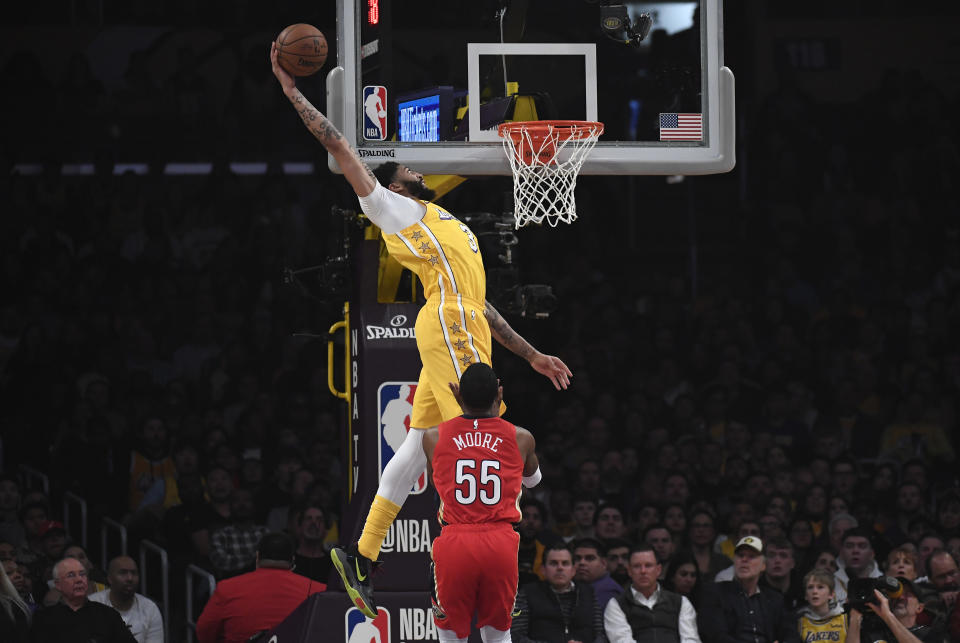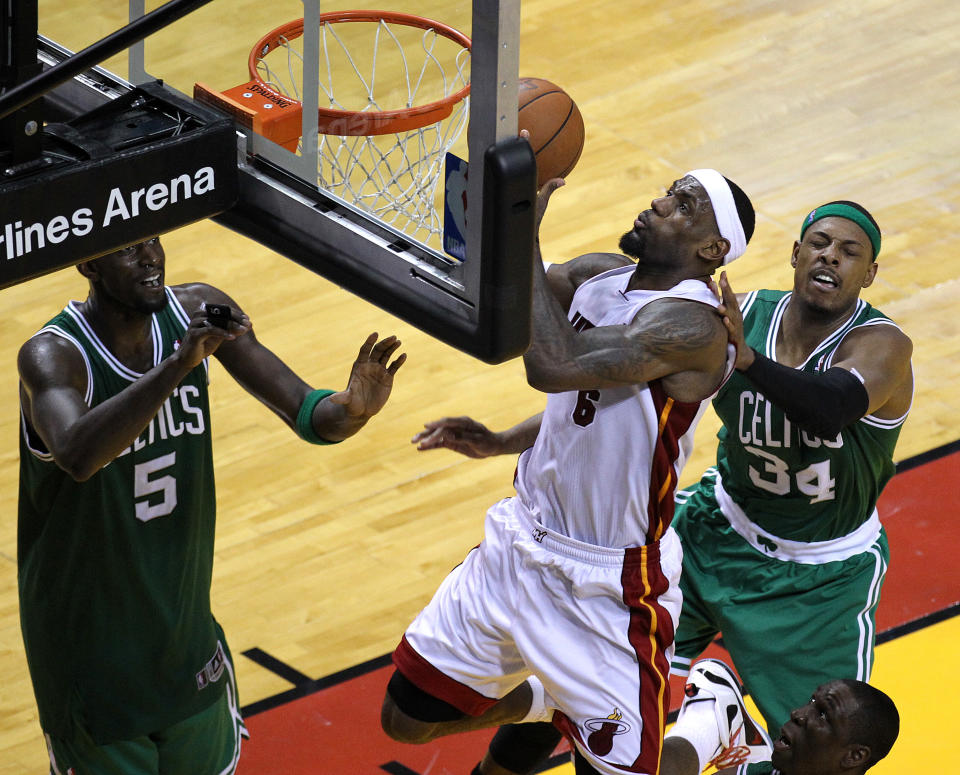An appreciation of the efficient anomaly that is the Lakers
A weekly dive into the NBA’s hottest topics.
The Lakers don’t need space to score in the paint
Dallas Mavericks coach Rick Carlisle, in defense of Kristaps Porzingis, his 7-foot-3 center who spots up from three instead of posting up in the paint, called posting up “counter-intuitive.” Charles Barkley and Shaquille O’Neal would probably call it a shame. It’s the Milwaukee Bucks’ present, and maybe the NBA’s future: If you want to score in the paint, clear it. If you want to shoot open threes, get in the paint. To determine what a coach believes to be the court’s most fertile scoring opportunities, don’t look where his players are standing. Look where they’re not.
Thanks to a proliferation of frenzied ball movement, it’s never been easier to leverage the threat of one shot to get another. That’s why you’ve got former players lamenting the death of the post-up, all the while Giannis Antetokounmpo sets paint scoring records that rival only Shaq’s. But Antetokounmpo is not a bruiser; he’s a driver with an open runway.

The Los Angeles Lakers, on the other hand, are running roughshod over the modern playbook. Instead of driving into the paint, like the rest of the NBA, they stand in it — to great success.
Anthony Davis isn’t exactly a traditional big man. But he’s not an analytics darling either, shooting 29.7 percent from beyond the arc and posting up 5.4 times a game. Despite that, Davis has thrived alongside Dwight Howard and JaVale McGee, whose ranges are locked in a 10-foot radius from the rim.
Who needs horizontal space when the Lakers can dominate vertical space? McGee, Howard, Davis and LeBron James can suspend themselves mid-air for just a quarter-second longer than their opponents. The bigs are paid to be long, imposing, easy targets for passers, and they’ve bucked league-wide trends by going back to brass tacks, committing to habit the simple but hard-learned tenets of every high school basketball coach: Once you get the ball high up in the air, don’t come down with it. Just shoot.

So despite clogging the lane — they’re second in post-ups and paint touches — the Lakers lead the NBA in field-goal percentage (and points) in the paint and restricted area. Davis finishes a staggering 74.8 percent of the shots he takes at the rim, the second-highest conversion rate for any big man in the top-50 in attempts outside of Antetokounmpo, while operating from much tighter spaces. Howard doesn’t have enough attempts to qualify, but he’s finishing a whopping 81.7 percent of those shots.
Modern NBA defenses necessitate a world where McGee shooting an open hook shot over Luka Doncic is as simple as getting a guard to set an off-ball screen and sweeping into the lane. Because most teams don’t hunt individual matchups in the paint very much anymore, defenses can get away with switching just about anything in the interior. That’s where the Lakers eat, which will make the playoffs, when opponents scout more specifically, interesting. For now, they run the fourth-most efficient offense in the NBA.

The moment of the decade
Even when we consciously take the longview, recency bias can rear its head. We’ve reflected on the decade that’s come to pass and then reflected on our reflections, but it still feels like the early part got short shrift. One game in particular comes to mind: LeBron James’ Game 6 performance against the Boston Celtics in the 2012 Eastern Conference finals.
He had already been anointed, but his greatness wasn’t yet self-evident. His mettle was still a point of debate, perhaps for good reason. To that point, LeBron had fallen short in the postseason, and he was at risk of following up his disastrous performance in the 2011 NBA Finals with another disappointment. Trailing the Celtics 3-2, almost two years removed from The Decision and the infamous, “Not one, not two …” celebration, James’ back was pinned firmly against the wall. It was the moment we found out who he was going to be.
In the most important moment of his career to that point, James delivered the best game he had played, delivering 45 points and fifteen rebounds in a capital “V” victory. His patented smile, reflecting a carefree demeanor that occasionally drifted into punishable carelessness, was replaced by stoic disregard for everything but the obstacles between him and the rim. I remember having no idea what to expect. Even the stone face, what we now understand as some form of clinically focused anger, could have been read as disengagement.
His fans had hoped he had the performance he gave in him, but no one really knew. He could have been The King, he could have been what Skip Bayless thought of him. He hadn’t shown enough yet. He had never had the by-any-means, at-all-costs, screw-you performance he gave that night.
It was one of the most important moments of the decade because the best player in the universe channeled something he never had before, allowing him to put his stamp on the years to come. He learned who he was alongside us on his way to his first championship. Among the things he overcame was his own entitlement. When James joined the Heat, he said it was going to be easy. Over the next two years, culminating in Game 6, he realized an accomplishment of that magnitude would require something deeper, a reservoir that would be anything but easy to tap into.
On the Bill Simmons podcast, Kevin Garnett said the 2010 Celtics broke LeBron. In reality, they cracked a shell that allowed him to peel back and find a layer he didn’t know he had.
From my silver-linings playbook
The race for the eighth seed, particularly in the Western Conference, is uninspiring to the point of absurdity.
For example, here are some upcoming matchups that could have playoff implications: the 16-20 San Antonio Spurs, who currently hold the eighth seed, take on the ninth-seeded 16-22 Memphis Grizzlies on Friday. The 13-25 Chicago Bulls are right on the heels of the 14-25 Detroit Pistons, who they play on Saturday, and both teams would love to see the 15-25 Charlotte Hornets lose to the Utah Jazz on Saturday.
Almost everybody is still in it, but nobody has been able to dig themselves out the muck and distinguish themselves out of a fairly undistinguished pack and put together an inspiring but at the very least respectable record that’s just a few games under .500. The Minnesota Timberwolves, who are two games back of the eighth spot in the West, would have been the second-worst team in the NBA last season, based on win percentage.
There could, aside from the small possibility of the Lakers or Bucks cracking 70 wins, be one silver lining: An inappropriately young team making the playoffs.
This season has been evidence enough: NBA superstars swallow up the narrative of the season to the point that their younger counterparts get little to no shine. It’s the nature of the beast, and in down years, it hurts the NBA’s ability to market itself. There’s no better stage for rookies like Ja Morant or Zion Williamson or a young core like that of the Phoenix Suns to show the world who they are.
So with all due respect to the Spurs, who could break the NBA record of 22 consecutive playoff appearances — not bad, right? — I’m going to be cheering for the Grizzlies on Friday.
More from Yahoo Sports:

 Yahoo Lifestyle
Yahoo Lifestyle 
